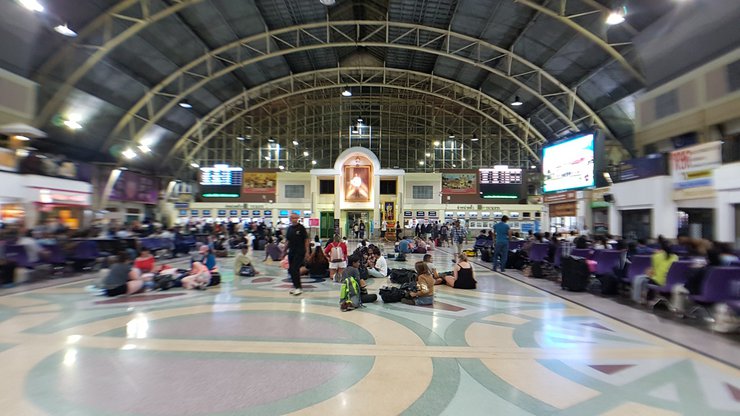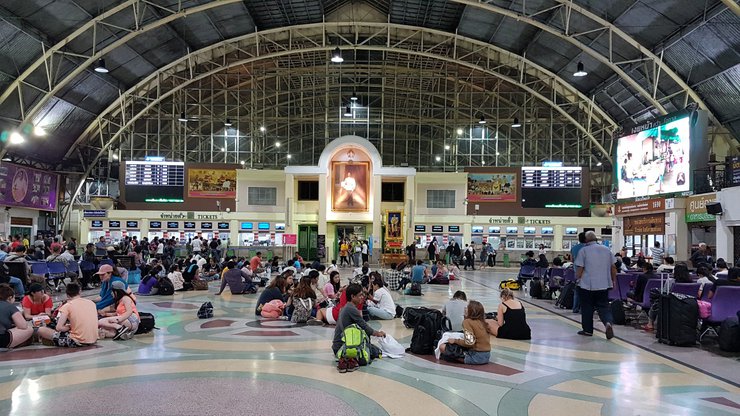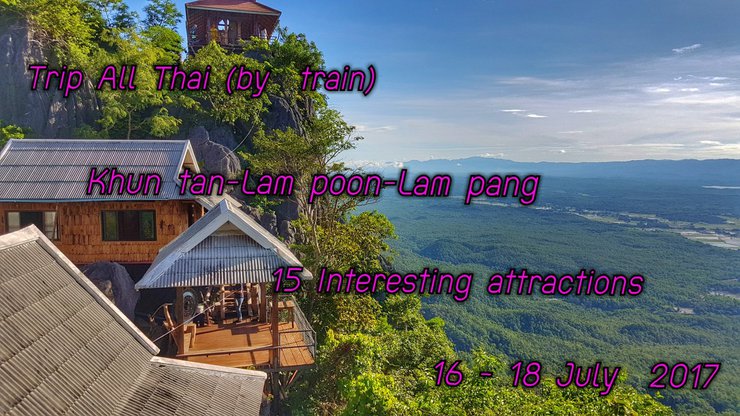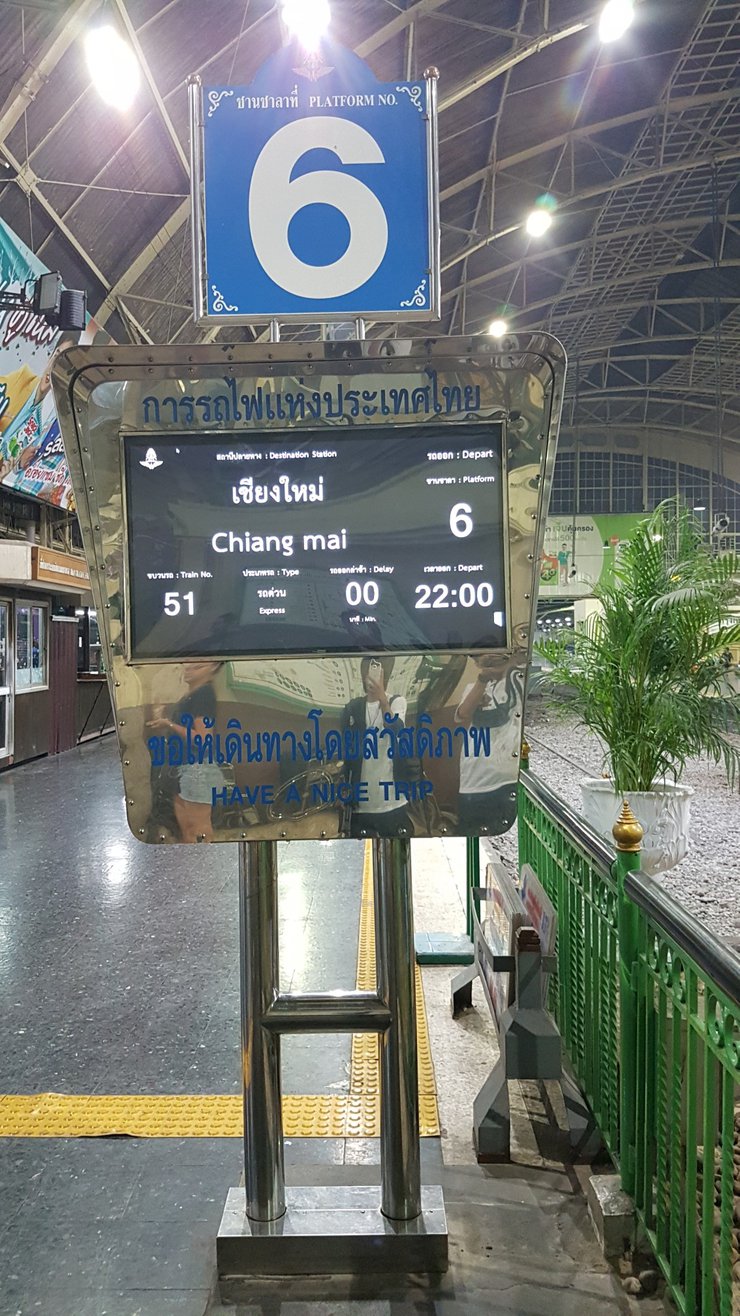
Hello everyone, this trip, our page "Deawpapai" will take you on a backpacking adventure by train, capturing the coolest atmosphere for 2 days and 3 nights with stunning views and 15 unseen tourist attractions in Khun Tan National Park - Lampang. For those who want to travel but don't have any information, this trip might be an option for you to realize that comprehensive travel doesn't always require a lot of budget. "Travel with us, complete, low budget".


Here, at Hua Lamphong, may be a destination for many people, but for us, it is the starting point. Our journey for this trip begins here.



Due to the high volume of travelers on Friday, we booked our train tickets 15 days in advance. We will be traveling on Express Train No. 51, departing from Bangkok at 22:00 and arriving at Khun Tan Station at 11:05 the next day. We chose a second-class sleeper car with a fan to enjoy the beautiful scenery along the way (the windows of air-conditioned cars tend to fog up).



Here are the faces of our trip participants. We will have one more member joining us in Lampang.





21:40 p.m. The train arrived at the platform. It was time for us to board the train.

Inside the second-class sleeper car, after the sleeping car staff transformed the seats into beds.

After chatting for a while, we arrived at Ayutthaya Station. We sat for a while until our batteries ran out, and then we all went to sleep.



Waking up at Uttaradit station. 😁😁 After this station, the train line will start to climb the mountain until it reaches Khun Tan station. The scenery along this route is very beautiful.

After a while, we arrived at Den Chai Station, which will become a junction station in the future to separate to Chiang Rai Province.



I hope the journey is so enjoyable that you forget about your destination.
How far is it?

The train is passing through the "Khao Phleung" tunnel.



The scenery along the railway is unlike anything you'll find on other modes of transportation.

Passing through the "Pang Tub Khop" tunnel



The atmosphere inside the train is relaxed and comfortable.







A highlight of the Northern Railway Line is "Kaeng Luang," where the train runs along one side of the mountain, parallel to the Yom River in Phrae Province.



If you are hungry, you can walk to the pantry to order food.

The train is passing through the "Huai Mae Lan" tunnel.

We are warmly welcomed by another member who will be our tour guide throughout our trip at Lampang Railway Station.

Where will nature's greenery lead us? In a short while, we will arrive at Khun Tan Station, our final destination.

Crossing the Shuangta Bridge, one of the three high-altitude bridges on the North Railway Line.







The train is passing through the Khun Tan Tunnel, which means we must get off. This is what they call the light at the end of the tunnel.


11:10 AM, 5 minutes behind schedule. Who says Thai trains are always late and boring? We've arrived at Khun Tan Station, the highest railway station in Thailand, standing 573 meters above sea level. This station also boasts the Khun Tan Tunnel, which runs through Khun Tan Mountain and stretches 1352.10 meters long.
Let's take a thrilling photo! 🤣🤣
Near the train station, there is a path leading up to Khun Tan National Park.
The journey begins with a prayer to Chao Pho Khun Tal, seeking blessings for a smooth and successful trip.
A view looking back towards Khun Tan Railway Station
After taking some memorable photos, we ascended to the top of the tunnel for a bird's-eye view.
The view from the top of the tunnel is breathtaking, making it hard to leave.
The tour participants took photos to their heart's content, and we went to eat papaya salad next to the station. Let me tell you, it was amazing!
Thank you for following. I will update you with 15 tourist attractions as soon as possible.


Our second trip takes us to the @Saphan Rot Fai Tha Chomphu, a popular destination for both Thai and international tourists. The Tha Chomphu Railway Bridge is a stunning structure located within the picturesque landscape of Mae Tha district, Lamphun province.

The distance is not too far, only 11 kilometers.

We have arrived. Let me tell you, the atmosphere is amazing!





The actual location is incredibly beautiful, with lush green trees, mountains surrounding it, and clouds drifting by. At night, backpackers gather at the Tha Chom Phu Bridge to camp and stargaze.




Although the sun appears scorching, it is actually surprisingly cool here.
After capturing various shots, we took a group photo before embarking on our third trip.
Video review of episode 1 of the Khun Tan - Saphan Ta Cham Phu trip. https://m.facebook.com/story.php?story_fbid=125002208085165&id=100017261599333


Our third trip took us to Khun Tan National Park, only 12 kilometers from the Tha Chomphu Bridge.

The entrance fee to the park is 20 baht per person. For 4-wheel vehicles, the fee is 30 baht per vehicle.







How much hotter can it get?!



Take a short walk to the park's scenic viewpoint for a photo opportunity.


Let's take a picture to remember this moment.
Sign indicating the railway tunnel under Khun Tan Mountain.
The train zoomed into the tunnel, revealing its true form.
The highlight is the boundary between Lampang and Lamphun.
This stunning image concludes our third trip.
Let's move on to @trip #4. We will travel to take pictures at the highest railway bridge over a ravine in Thailand. Few people have been able to visit this place.

The distance from Khun Tan National Park to the composite railway bridge is approximately 8 kilometers.

Our tour guide did an excellent job leading us on our tour. ^^



We have arrived and parked our car by the roadside. The atmosphere is incredibly lush and green.



To reach the photo spot, you need to walk approximately 150 meters through the forest.

The Composite Bridge: A Landmark in Railway Engineering
The Composite Bridge stands as a testament to innovative engineering, marking the first of its kind for the State Railway of Thailand. This remarkable structure serves as one of three railway bridges spanning a deep valley along the Northern Line, connecting Mae Taeng Noi and Khun Tan stations at kilometer 676.754.




Capturing the breathtaking views and the refreshing atmosphere. ^^
The view from the bridge is like this.
We took some memorable photos at the composite bridge. After capturing the perfect shots, we headed to our fifth destination.
Our next trip, the fifth one, will be to pay respects to Chao Pho Khun Than (Phaya Beik).

The distance from the composite bridge is 19 kilometers.



After a short drive, we arrived at the entrance of the Khun Tan Historical Park (Phaya Beik). Phaya Beik was a brave and loyal warrior who led his troops to battle to help his father reclaim the city. He died in the battle, and his story has been passed down through generations. He is now known as Khun Tan, and a sacred shrine has been built in his honor near the Khun Tan cave, close to the Khun Tan train station.



Despite the sweltering heat, I felt an overwhelming sense of fulfillment.

Could you please provide me with your biography?


We are currently in the process of updating some of our exhibits. Please continue to take photos.
We concluded our trip with a commemorative photo before embarking on our sixth adventure.


Our sixth trip will take us to @Wat Phra That Lampang Luang, which is not too far away according to Google, about 19 kilometers.

We will arrive shortly.





The majestic and magnificent Wat Phra That Lampang Luang is a significant historical site located within the ruins of the ancient city of Lamphun. According to historical records, Queen Chama Thewi visited the temple and oversaw its restoration and maintenance. This temple has served as a vital landmark for the city since ancient times. Its architectural, sculptural, and artistic splendor are remarkable. The temple houses the revered Phra Kaew Don Tao, a sacred Buddha image revered by the people of Lampang and Buddhists worldwide.





Capturing a wide-angle view of the temple entrance serves as a reminder of our visit to this sacred place.



Upon entering the temple grounds, you will find complimentary chilled drinking water. Enjoy the refreshing coolness!

The grand pagoda exudes a powerful and captivating aura.











Explore the area around the ordination hall. This is a popular spot for both tourists and locals to pay their respects. If you are a woman wearing a short skirt or shorts, you will need to change into a sarong provided by the temple at the entrance below.

This temple houses a small stupa beside the main chedi. However, the unseen lies within the small stupa itself.

The sign at the entrance reads "No women allowed."



The interior of the stupa is very dark. Upon entering and closing the entrance door, one can observe the gradual refraction of light penetrating the white walls of the stupa.

We will see the inverted image of the pagoda due to the refraction of light, creating a shadow of the stupa.

Let's take one more picture inside the temple for good luck.

Very beautiful ^^

The exhibition also features wax replicas of revered monks.

When visiting Wat Lampang Luang, don't forget to stop by and try the fortune-telling elephant. It is said to be very sacred.
A brass elephant, approximately five inches tall, stands with a message inscribed on it detailing the process of lifting the elephant to make a wish. The individual should kneel in front of the elephant, with their side parallel to the elephant's. First, they should make a wish and then lift the elephant, which has a ring on its back for this purpose. Women should use their ring finger, and men should use their little finger. If the individual can lift the elephant, it signifies that their wish will come true. They can then repeat the process, focusing on the same wish. However, if they are successful the first time, they will not be able to lift the elephant again.

This concludes the sixth trip with this beautiful picture.

From here, we will travel to Wat Phra That Doi Phra Chan, which is about 25 kilometers away according to the map. Let's go!

The seventh location, Wat Phra That Doi Phra Chan, is a temple with an ancient and little-known stupa. Situated on the southwestern mountain range of Pa Tan Na Khrua Municipality, it falls within Moo 5, Pa Tan Subdistrict, Mae Tha District, Lamphang Province. This area borders Mae Tha, Ko Kha, and Sop Prap Districts. The surrounding area boasts stunning scenery and a viewpoint offering rare panoramic views of Mae Tha District. The temple provides a peaceful and serene atmosphere.







Despite arriving in the late afternoon, the atmosphere remained pleasantly cool and refreshing.







Let's explore the temple grounds... If we come here early in the morning, we can see a sea of fog.

The highlight is behind the ordination hall, where you can see a distant view. Follow me!

The scenery is already beautiful in the evening, so how beautiful would it be if we came in the morning and saw the sea of fog? ^^
There were stairs leading down, but we didn't go down them.
The breathtaking panoramic view erases all traces of fatigue. Truly extraordinary.
After taking a group photo, we explored a little more as the light was fading fast.
This image concludes our seventh trip.
Watch the video review ep.2 of the Khun Taan Shrine - Phra That Doi Phra Chan Temple https://youtu.be/tk4b_kaXKQY
After completing our 7th trip, we went to the hotel we had booked, which was about 500 meters from Lamphang Railway Station.
@Inhlong Home: "Affordable Accommodation with Million-Dollar Views"
Starting at just 490 baht per night, Inhlong Home offers comfortable air-conditioned rooms with TVs, refrigerators, and hot water showers. Guests can enjoy complimentary coffee and Ovaltine, as well as free bicycle rentals. Motorcycle rentals are also available for 200 baht per day.
InLhong Home Resort Facebook Page


Trip #8
The Kad Kong Ta Walking Street is one of the top 10 walking streets in Thailand. After taking a shower and resting, our friendly guide took us for a walk to enjoy the view at the Kad Kong Ta market, which is only about 3 kilometers from our accommodation at Inhlong Home.



The crowd was massive today, but luckily it didn't rain, so everyone could walk around comfortably.



Thai children played traditional music for the tourists. Some kind tourists gave the children a small amount of money as a reward.





The food here is very cheap. For example, popsicles with Coke, green juice, red juice, or orange juice like this would cost 5 baht per stick in Bangkok's Chatuchak market, but here, 3 sticks cost 10 baht. If you buy a lot, the vendor will be kind and give you more. ^^ I love Kad Kong Ta.







The majority of the offerings are local products and traditional cuisine.





Eating while walking is an incredibly enjoyable experience.



After a tiring walk, we met up with a close friend whom we hadn't seen for seven years. Our friend, knowing that the Trip All Thai team was visiting Lampang, offered to treat us to a meal. We dined at "Rung Yum Zaeb" restaurant, and I must say, the food was absolutely delicious. Not only were we satisfied with the food, but we were also filled with joy and gratitude for the word "friend" and the realization that "friendship knows no boundaries."

Rung Yum Zaap Restaurant is located in Soi Ling Chan Man, Kad Kong Ta Market. If you're looking for delicious food, this is the place to go. Call 0931365546 for more information.
After a satisfying meal, we intended to return to the hotel. However, noticing the "Saphan Ratchaphisesok Bridge" nearby, we decided to make a quick stop for some photos.
Beautifully decorated with lights
It's a bit creepy. 🤣🤣🤣
The day's final trip concludes with a group photo at the "Saphan Ratchaphisesak" bridge.


Trip 9: Paying respects to Luang Pho Kasem Khemagko. We departed from our accommodation at 5:30 AM. According to Google Maps, it was only 6 kilometers from the city center. Luang Pho Kasem Khemagko, also known as Khru Ba Kasem Khemagko (formerly known as Chao Kasem Na Lampang), was a highly respected monk and spiritual teacher who strictly adhered to the ascetic practices of dhutanga and lived in seclusion. Buddhists in Lampang Province and throughout Thailand revere him as one of the country's most revered monastic teachers. He is still revered by many people today. He was also a member of the royal family of the Tipchak Dynasty who chose to become a monk.



We arrived at 6:00 AM, which was still very early, so we were unable to enter the ordination hall to pay respects to the body of the deceased. We could only take pictures of the outside atmosphere.


Let's explore the inside of the temple together. ^^
Capture a memorable image of the ninth location on this trip.




Our next destination is Wat Chelimphong Phra Chom Klao Rachanusorn (also known as Wat Luang Pi Jazz), built to commemorate the 200th anniversary of the birth of King Rama IV (October 18, 2004). It is located approximately 58 kilometers from our current location, according to Google Maps. Let's head there now!





This temple is divided into three levels. The first level houses the temple and resident monks. The second level serves as a parking lot with shops and restrooms. The third level is the top of the stupa. Upon arrival, visitors must park their vehicles at the first level and transfer to a 4x4 high-clearance vehicle provided by the temple to reach the second level. The road beyond this point is challenging. The round-trip transportation fee is 100 baht per person. The vehicle will depart once it is full.

The interior of the car that will take us to the 2nd floor of the temple 😁😁





Video review of the ascent https://youtu.be/zPZqxzoOLZg
The ascent to the mountain is approximately 3 kilometers, which is as challenging as the climb to Khao Khitchakut. However, vehicles cannot pass each other on this route. A queue system is in place to prevent collisions. Vehicles ascend until they reach the summit, and then descending vehicles are allowed to proceed. It is highly recommended to find something to hold onto during the ascent, as the road is notoriously steep and treacherous.

We arrived at the temple very early in the morning, among the first groups of the day. There are restrooms available next to the entrance. Please take care of any personal needs on this level, as there are no restrooms available on the upper levels, which we will be reaching on foot.









Before reaching the walkway to the 3rd floor of the temple, there is a replica cave.

This is the only shop in this area. It is recommended that everyone buy a bottle of water as there are no shops or water services at the top.





There will be a fake path to trick us for about 300 meters. The real one is after this. 🤣🤣🤣





The walkway is constructed with alternating sections of steel plates and stairs, providing a sturdy and comfortable path for walking.

One of the Trip All Thai team members is very diligent in filming videos for the Trip All Thai YouTube channel.

Let's continue walking and taking photos.

Not tired at all, just standing here to rest for a bit. 🤣





We continue walking. The author is starting to get tired. 55 !!

The journey is still long, we must walk to the top of the mountain.

The sign indicates that we are almost there.

It's a bit out of breath. ^^



Almost there.



Our team is in top shape!





We have arrived! It's absolutely stunning. It took us about 30 minutes to walk up here. The scene before us is exactly like the one in the movie "Luang Phi Jazz".

There is also a bell to ring.
Let's explore the surroundings together.
The sun is out, but the air is still pleasantly cool.
Top view of the pagoda.
The view is beautiful...the wind is cool...the green mountains as far as the eye can see...the point on the pagoda if you look down is quite loud, but there is a steel railing to keep you safe.
Let's pay respects and make offerings to the Buddha statue at the pavilion for good luck in life.
Let's mop the floor a little. ^^
Let's take a moment to capture this thrilling moment! After resting and recovering from our fatigue, it's time to descend from the temple.
The descent was a joyous occasion due to its ease.
Let's go take some photos!
After a quick 15-minute break, we refueled at a nearby café before heading to our eleventh destination.
Video review ep.3 Luang Pho Kasem Khemago - Wat Chalermprakiet Phra Chom Klao Rachanusorn


According to Google Maps, we need to drive another 21 kilometers.





The journey by car takes approximately 30 minutes. The entrance fee to the park is 40 baht per person. Motorcycles are charged 10 baht, while 4-wheel vehicles are charged 30 baht.





The first thing I did after getting off the bus was to "eat." An army marches on its stomach.



This restaurant also sells eggs for boiling. The food here is reasonably priced. You can eat at the restaurant or take it down to the waterfall to eat. The restaurant will deliver it to you.





After ordering food, we walked around to explore the area and find a suitable spot to enjoy our breakfast.



Let's walk to the hot spring. The heat is really intense.

The water here is extremely hot, reaching a temperature of 82 degrees.

Don't forget to take a selfie to capture the memory of our visit here.







After finishing our meal, we took in the breathtaking scenery. The beauty of this place is simply indescribable.

Uncle Clear...

Cool flow....

I see the fish.




After taking photos to our heart's content, we went to the hot springs to relax.
Inside the onsen bathing facility.
After soaking in the onsen, we walked up to the waterfall. It was getting crowded, but still incredibly beautiful.
This concludes the 11th trip with this picture.
Trip #12 @ Enjoying the breeze and the view at Kiew Lom Dam

The distance from Google is quite far, about 53 kilometers. How beautiful the view of the dam ridge will be, follow us.

Drive along, enjoying the breeze and the scenery on both sides of the road.

It takes about 50 minutes to drive to the photo spot on the dam crest. The weather is pleasantly warm.

On the other side of the dam, looking into the distance, I feel truly refreshed.







Group photo session is also available.

There are also beautiful photo spots.
We spent approximately 40 minutes at the dam crest due to the relatively hot weather.
This concludes the 12th trip with this picture.
The next destination we will be visiting is location 13, Tham Pha Thai Cave, which is part of Tham Pha Thai National Park.

The journey begins approximately 59 kilometers from the Kiew Lom Dam. Let's embark on this adventure together!







After approximately one hour's drive, we arrived at the 13th tourist spot, Pha Thai Cave. This cave boasts a large hall formed from limestone mountains estimated to be at least nine million years old. The cave extends approximately 1,150 meters from the entrance. The park has installed electric lights throughout the cave to facilitate the observation of the numerous stalactites and stalagmites. Additionally, the cave contains volcanic ash dating back 15 million years, making it a unique geological wonder in Thailand. Notably, King Rama VII visited Pha Thai Cave in 1926, as evidenced by his royal initials inscribed within the cave. The cave is also home to a large bat population. Nearby, the historic Tiger Cave and Robber Cave are accessible by foot from Pha Thai Cave. Visiting Pha Thai Cave requires a hike to reach the entrance. It is important to note that prior notification to park officials is necessary for cave exploration. The park will then activate the cave's lighting system; otherwise, the cave remains unlit, making exploration difficult. Park officials provide guided tours free of charge. However, upon the cave's official designation as a national park, an entrance fee is likely to be implemented. The park provides flashlights for visitors, eliminating the need for personal illumination.

The path is long and arduous.

Follow us.

Walk…

And then walk…

Rest when you're tired, then keep going.

Looking back down at the path we climbed, the atmosphere is humid and cool now, as we arrived around 3:00 PM.

I've arrived. I'm a bit tired, but not out of breath. ^^

The atmosphere is eerily quiet, with only the sounds of crickets, frogs, birds, and a gentle breeze. The climb up to the entrance of the Pha Thai Cave, with its few hundred steps, is not particularly steep, but it can still be tiring. By the time you reach the halfway point, you may find yourself slightly out of breath.

Our suicide squad has gone down. What should we do, Sir?







The first feeling upon entering the cave was a sense of awe and grandeur. The silence and beauty were overwhelming.



The Trip All Thai team couldn't resist taking a group photo to commemorate their arrival. 😁😁

As I was still marveling at the beauty and grandeur of the cave, before I knew it, our team had already descended to the bottom of the hall. Hey, wait for me!







The cave is very cool and quiet.

Lion-shaped stone



The cave of Tham Pha Thai bears the royal initials of King Prajadhipok (Rama VII), who visited the site in 1926.





There is a Buddha statue at the entrance of the cave. Visitors typically pay their respects and make offerings before exploring the cave's interior. The statue depicts the Buddha in the "First Path" posture, which resembles the "Meditation" posture but with the right hand raised in a gesture resembling a pinched finger. It is believed to be the only "First Path" posture Buddha statue in Thailand. The statue is located at the mouth of the Pha Tai Cave and is frequently visited by locals for worship. If visitors come solely to pay respects to the Buddha, they are allowed to enter the cave without the need for a guide. The history of the statue's creation remains unclear.



The nine-million-year-old stalagmite is located behind the Buddha statue. According to the information provided by the staff, the stalagmite is estimated to be nine million years old. Typically, stalagmites in caves grow at a rate of one millimeter to half a centimeter per year. The height of this stalagmite suggests that it would take less than nine million years to grow to the ceiling of the cave. However, samples of rock and soil found near the stalagmite were sent to a laboratory abroad, which confirmed that the stalagmite is at least nine million years old.



The cave ceiling features a natural light shaft that illuminates the cave floor. The light is particularly stunning during the morning and midday hours.



Looking back towards the mouth of the cave, the deeper you go, the darker it gets.

We were accompanied by a park ranger who served as our guide and provided us with insightful information.





The path is illuminated at intervals. The cave of Tham Pha Thai is a spacious cave with several large chambers. The ceiling is relatively high, even though the cave is 405 meters deep. The air is breathable, and there are two openings in the ceiling. Some sections of the path are narrow and require passing through crevices in the stalagmites. Even men of average build who are not overweight may find it difficult to pass. If you are not in good shape, you may not be able to pass through.
After walking for a while, we came across a sign that read "Id Koi Cave Disappeared." This was a岔路 of the cave, but the officials had closed it off due to the dangerous path and the abundance of snakes.
Water dripping from the tip of the rock can cause stalactites and stalagmites to form.
As we walked, the guide pointed out a rock formation growing from the ground. This rock is still in the process of development.
We continued walking. Inside, there were many bats clinging to the cave ceiling, and the smell of bat droppings was strong at times.
Stalactites: Formation and Appearance
Stalactites are white, elongated mineral deposits that form on the ceilings and walls of caves. Their formation begins with cracks or leaks in the cave's ceiling, allowing water and carbonic acid to seep through. These fluids dissolve minerals from the surrounding rock and carry them downwards. As the water evaporates, the dissolved minerals precipitate and accumulate, forming the stalactite.
The size of a stalactite depends on the size of the opening in the ceiling. Large cracks produce large stalactites, while smaller openings result in thin, elongated formations. The color of a stalactite is typically white, but it can vary depending on the minerals present in the water. Notably, the color of a stalactite will often differ significantly from the surrounding cave wall, indicating its recent formation.
The Enchanting Stalactites of Anodard
The Anodard stalactites are a mesmerizing example of cascading rock formations. During the rainy season, water flows from the cave ceiling and collects in a large pool above the stalactites. This pool is believed to hold sacred, divine water, and locals often gather to collect it for consumption. The slow, continuous overflow from the pool contributes to the growth of the surrounding stalactites, creating a breathtaking spectacle.
The path continues, and the air becomes thinner the deeper you go. Some sections are narrow, so please be careful when walking.
The stalactite is a dead example of stalactites. These stalactites have stopped growing. Officials speculate that someone discovered this cave hundreds of years ago and may have broken off the tip of the stalactite for some purpose. The stalactite then took on a strange shape, like a blunt stone. After that, the growth of the stalactite at this point stopped.
The end of the Pha Thai Cave tour is reached at this point, 405 meters into the cave's depth. The cave is actually about 1 kilometer deep, but the path beyond this point is difficult, with many narrow passages that require crawling. Some sections are also quite dangerous and slippery. Therefore, officials only allow visitors to see half of the cave's total depth. Another reason why it is advisable to have officials guide tours of the Pha Thai Cave is that a large number of bats live in the cave, and there are also some species of snakes that are native to the cave. Officials say that most of the snakes in the cave are not venomous, and the guides will ensure the safety of tourists.


Having come this far, entering is no easy feat. The team did not forget to capture the thrilling moment at @Tham Pha Thai.


After giving it our all, we headed back because we still had 2 more places to visit to complete our journey. ^^
The final image of Tham Pha Thai at the local tradition sign.
Video review ep.4 Khao Chet Son National Park - Tham Pha Thai Cave
The next stop on our journey is Wat Chong Kham, our 14th location on this trip.

The distance from Tham Pha Thai Cave to Wat Chong Kham is only 8 kilometers.

After driving for a while, I arrived. The overall condition seems to be under construction or renovation.

Upon arrival, we took a commemorative photo, but it was challenging due to the pagoda's immense height. Our wide-angle lens was insufficient to capture the entire structure within the frame.

Behind the scenes of the shoot, the investment was huge!

Due to the immense size of the new Mahabodhi Mahavihara, capturing a wide-angle shot proved challenging. The sheer scale of the structure limited the extent of the panorama.

Wat Chong Kham, a royal temple, is located on the Lampang-Ngao Highway (Highway No. 1 or Phahonyothin). If traveling from Tak Province or Bangkok, Wat Chong Kham will be on the left-hand side. With its beautiful golden archway and long stone wall stretching over 200 meters, Wat Chong Kham is a striking sight for travelers.

The Indian state of Bihar is home to the Mahabodhi Temple, also known as the Mahabodhi Mahavihara, which is a UNESCO World Heritage Site. The temple is located in Bodh Gaya, which is considered to be one of the four holy sites associated with the life of Gautama Buddha. The Mahabodhi Temple is said to have been built on the site where Buddha attained enlightenment under the Bodhi Tree. The temple complex includes a number of other structures, including a monastery, a stupa, and a sacred pond. The Mahabodhi Temple is a popular pilgrimage destination for Buddhists from all over the world.





The interior is remarkably clean and the air conditioning is refreshingly cool, a stark contrast to the sweltering heat outside. This serene environment is ideal for practicing Vipassana meditation.



Interior atmosphere
After spending some time meditating and chanting with the monks at Wat Jong Kham, we will head to the final and most unseen destination of this trip.
After leaving Phra Buddhabat Bua Bok, we will travel to @Lohm Phu Khiao, a sacred and unseen place in Lampang province.

From Buddha Gaya, it's a 20-kilometer journey. We need to hurry because it's getting late, and we don't want to miss the sunset. Let's go!

The first 16 kilometers are paved and easy to drive, but the last 4 kilometers are dirt roads.



The road is now unpaved. During the rainy season, the road can be very slippery. Please drive with caution.





The road gradually leads deeper into the forest.



This path was originally only accessible to farmers' tractors. After the area was developed and opened as a new tourist attraction in Lampang, the city that should not be missed, the dirt road surface was leveled to make it more accessible to vehicles. However, vans will get stuck at the last 200 meters before reaching the green pit due to the stream. Going down from here, you will encounter a stream or small creek, but we came during the dry season, so the water was dry and we could cross it easily. However, if it is the rainy season, there will be a stream, and if you come by motorcycle, you may not be able to cross it.

After driving for about 30 minutes, we arrived at the parking lot. However, since we arrived in the evening, the area was not crowded.

The Phukhieo Sinkhole is located within the Tham Pha Thai National Park, approximately 32 kilometers from the park headquarters. To reach the sinkhole, take the Lampang-Ngao route for 19 kilometers, then turn left onto a side road for another 13 kilometers. The final 4 kilometers are on a dirt road.

The path to the green pit starts from the parking lot. You need to walk up a short hill for about 150 meters to reach the clear pool. The first part is uphill, and then it's a long downhill walk.





After a short walk uphill, there is a resting area where you can take a break.





I have found a way down.

At the end of the trail, you will find the Shrine of the Father of the Green Pit. Before descending, it is customary to pay respects at the shrine, as it is a sacred landmark in Green Pit.

The right hand of the court will be the way down to the pool.

Upon reaching the site, a crystal-clear, turquoise pool comes into view. The water is so still that it perfectly reflects the towering cliffs encircling it, resembling a volcanic crater. For ease of access, the park has installed stairs. This large body of water is remarkably deep, appearing green due to its depth, which remains unmeasured. It is believed to have formed from the Earth's crust collapsing in ancient times. Villagers who discovered the emerald-colored pool nestled within the valley named it "Emerald Pool." Across from it lies a similar valley devoid of water, known as "Barren Pool." Locals believe the Emerald Pool is sacred and inhabited by a giant serpent, prompting them to hold an annual water-worshipping ceremony. According to elders, villagers used to offer bowls of rice accompanied by flowers, incense, and candles by placing them on a log and letting it float to the center of the pool as an offering to the spirits. The log would then mysteriously sink and resurface with the candles still lit, further solidifying the belief in the pool's sacredness. Consequently, villagers drink from the Emerald Pool, believing it to cure illnesses, and use it in their sacred rituals, a tradition that continues to this day. Visitors are urged to respect the site by not littering, releasing fish, soaking their feet, or feeding the fish, as the stagnant water can become polluted.
The water is crystal clear, so clear that you can see the fish. However, the author is unsure what kind of fish they are. These fish are native to the area, but no one knows how they got there. Locals say that someone once tried to fish there, but a sudden downpour forced them to leave. They released the fish back into the water and then told the story of what happened. Many of the fish in this pool are unidentifiable. The only one that is recognizable is a very large catfish. Officials are on hand to prevent people from feeding the fish or dipping their feet in the water. Locals have a great deal of respect for this sacred pool.
How can we miss a group selfie when we arrive at the green crater?
Video review of the atmosphere at Lom Phu Khieo. https://youtu.be/pYxD4pwB9Vg
The team dispersed to capture the impressive atmosphere, concluding the trip perfectly as planned before returning because it was starting to get dark.
The distance from Lumphukheaw to Nakhon Lampang Railway Station is approximately 100 kilometers. On the return trip, we need to make time as our train will depart from Nakhon Lampang Railway Station at 20:17.


We arrived at Nakhon Lampang Railway Station at 8:05 PM. The train was scheduled to depart at 8:17 PM. We had booked our return train tickets on the newest train in Thailand, the Special Express Train No. 10 "Utrawithi" from Chiang Mai to Bangkok. It was a second-class air-conditioned sleeper train that departed Nakhon Lampang at 8:17 PM and arrived in Bangkok at 6:50 AM.



There is still some time to take pictures at Lamphang Railway Station.

Train timetable at Nakhon Lampang Railway Station

As the train approached Lampang Railway Station, we took a group photo with the Trip All Thai team to commemorate our incredible two-day trip, which covered 15 tourist destinations and over 800 kilometers. We are grateful to "พี่แป๋ง," a member of Trip All Thai, who, despite some of us never having met before, made a lasting impression on us. พี่แป๋ง served as our guide and driver, expertly navigating the 800-kilometer journey and ensuring we visited all the planned destinations. "Friendship without borders" truly applies here. Thank you,พี่แป๋ง.

The train's announcement echoed as it pulled into the station, signaling the time for departure. With a heavy heart, I bid farewell to this enchanting place. I have fallen in love with its charm, its warm hospitality, and the captivating city of Lampang. If fate permits, I shall return to embrace its magic once more. @ThisIsLampang



Upon boarding the train, you will be greeted by touch-sensitive doors, reminiscent of a spaceship entrance. (Be warned, the air conditioning is extremely cold!)

A seat that can be converted into a bed.

The bed is made after the staff has laid the mattress.

One bottle of water is provided per seat.

Each seat is equipped with a reading light and a 220V power outlet.

The monitor displays real-time information about the train's current location, including the station it is currently at, the next station, its speed, the temperature inside and outside the train, and whether it is running on time or delayed. This detailed information is very helpful for passengers.

The train is equipped with a hydraulic lift system for wheelchair users to access the carriages.

There is one dedicated carriage for passengers with disabilities.



The toilet will be a vacuum system, similar to those found on airplanes.



After we had finished storing our belongings, we walked to the pantry to hold a meeting.

The hallway after many people have gone to sleep, but we are still awake. Hehe.

The atmosphere inside the pantry

The supply cabinet also has free Wi-Fi.



Wow! Even on the train, they can't resist a group selfie! 😁😁😁
The officer will dim the lights for you to sleep comfortably. We will sleep until Rangsit. Zzzzzzzz........
In the morning, the staff came to convert the beds into seating.
06:25 AM: The train arrived at Bang Sue Junction Station on time.
Video review ep.5 Loei-Bangkok
The trip has come to a perfect end. ^^
**Cost Summary:** This includes round-trip train fare, transportation costs, fuel costs, accommodation costs, and park entrance fees. **Please note that individual food expenses are not included.**
Thank you for following our journey on the Deawpapai page from start to finish. This review was created with no other purpose than to provide information for travelers who are interested but lack information. We hope that our review will be helpful in some way. Thank you.
Taeremix
Wednesday, October 9, 2024 5:57 PM






















